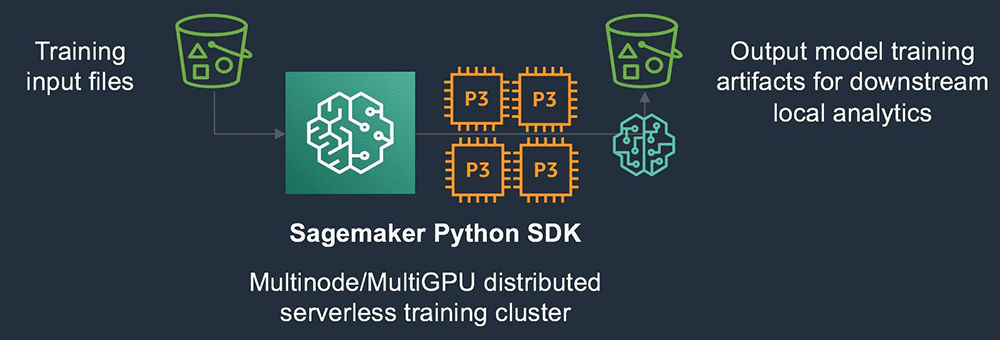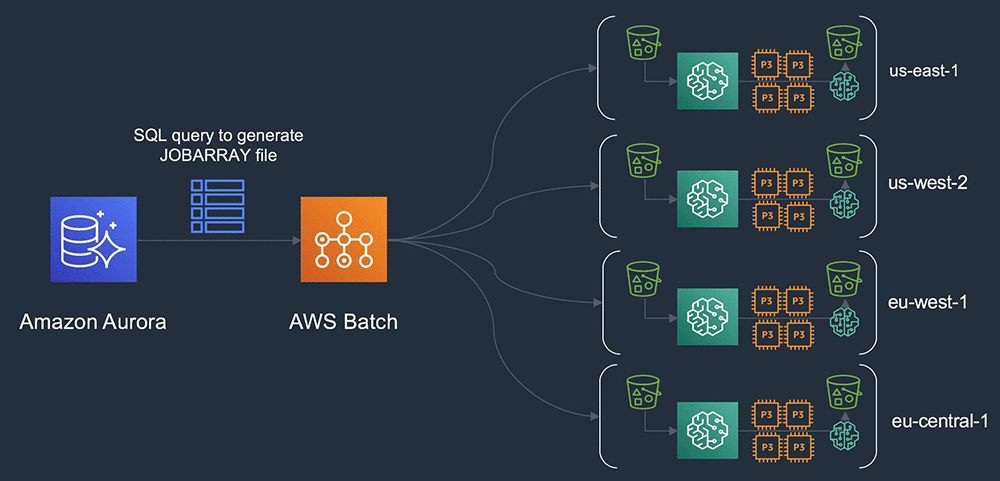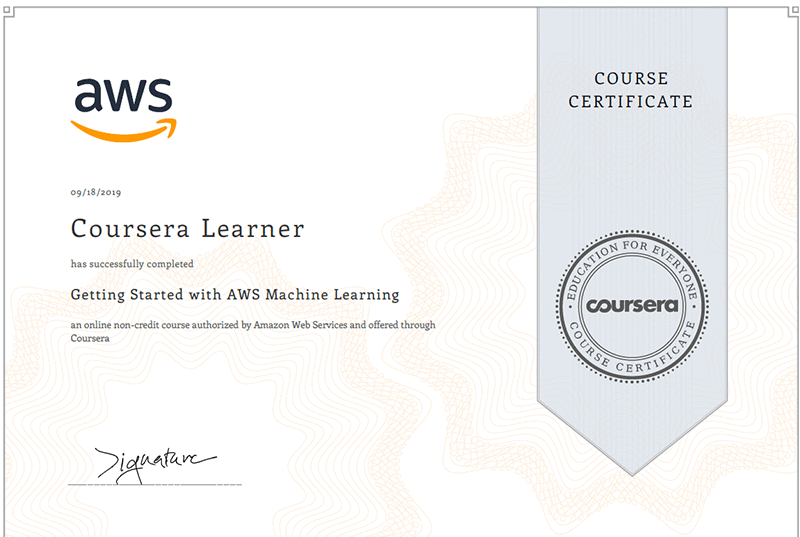Creating a global footprint and access to scale are one of the many best practices at AWS. By creating architectures that take advantage of that scale and also efficient data utilization (in both performance and cost), you can start to see how important access is at scale. For example, within autonomous vehicles (AV) development, data is geographically acquired local to the driving campaign. It is relevant and more efficient from a machine learning (ML) perspective to execute the compute pipeline in the same AWS Region as the generated data.
To elaborate further, say that your organization acquires 4K video data on a driving campaign in San Francisco, United States. In parallel, your colleagues acquire a driving campaign in Stuttgart, Germany. Both video campaigns can result in a few TBs of data per day. Ideally, you would transfer the data into Regions close to where you generated the data (in this case, us-west-1 and eu-central-1). If the workflow labels this data, then running the distributed training local to their respective Regions makes sense from a cost and performance standpoint while maintaining consistency in the hyperparameters used to train both datasets.
To get started with distributed training on AWS, use Amazon SageMaker, which provisions much of the undifferentiated heavy lifting required for distributed training (for example, optimized TensorFlow with Horovod). Additionally, its per-second billing provides efficient cost management. These benefits free up your focus for model development and deployment in a fully managed architecture.
Amazon SageMaker is an ecosystem of managed ML services to help with ground truth labeling, model training, hyperparameter optimization, and deployment. You can access these services using Jupyter notebooks, the AWS CLI, or the Amazon SageMaker Python SDK. Particularly with the SDK, you need little code change to initiate and distribute the ML workload.

In the above architecture the S3 bucket serves as source for the training input files. The SageMaker Python SDK will instantiate the required compute resources and Docker image to run the model training sourcing the data from the S3. The output model artifacts are saved to an output S3 bucket.
Because the Amazon SageMaker Python SDK abstracts infrastructure deployment and is entirely API driven, you can orchestrate requests for training jobs via the SDK in scalable ways.
In the previous AV scenario, for example, you can trigger the input training data from the uploaded dataset, which you tracked in a relational way. You can couple this with AWS Batch, which offers a job array mechanism that can submit these distributed training jobs in a scalable way passing relevant hyperparameters at runtime. Consider the following example architecture.

In this above architecture a relational database is used to track, for example, AV campaign metadata globally. A SQL query can be generated which populates the JOBARRAY input file in AWS Batch. AWS Batch then orchestrates the instantiation of the grid of clusters that are executed globally across multiple AWS Regions.
You are standing up a grid of clusters, globally deployed, based on data in Amazon S3 that is generated locally. Querying the metadata from a central database to organize the training inputs with access to capacity across all four Regions. You can include some additional relational joins, which select data for transitive copy based on the On-Demand or Spot price per Region and reservation capacity.
Deploying Amazon SageMaker
The example in this post runs the Imagenet2012/Resnet50 model, with the Imagenet2012 TF records replicated across Regions. For this advanced workflow, you must prepare two Docker images. One image is for calling the Amazon SageMaker SDK to prepare the job submission, and the second image is for running the Horovod-enabled TensorFlow 1.13 environment.
First, create an IAM role to call the Amazon SageMaker service and subsequent services to run the training. Then, create the dl-sagemaker.py script. This is the main call script into the Amazon SageMaker training API.
For instructions on building the Amazon SageMaker Script Mode Docker image, see the TensorFlow framework repo on GitHub, in aws/sagemaker-tensorflow-container. After it’s built, commit this image to each Region in which you plan to generate data.
The following example commits this to us-east-1 (Northern Virginia), us-west-2 (Oregon), eu-west-1 (Ireland), and eu-central-1 (Frankfurt). When support for TensorFlow 1.13 with Tensorpack is in the Amazon SageMaker Python SDK, this becomes an optional step. To simplify the deployment, keep the name of the Amazon ECR image the same throughout Regions.
For the main entry script to call the Amazon SageMaker SDK (dl-sagemaker.py), complete the following steps:
- Replace the entry:
role = 'arn:aws:iam::<account-id>:role/sagemaker-sdk'
- Replace the image_name with the name of the Docker image that you created:
import os
from sagemaker.session import s3_input
from sagemaker.tensorflow import TensorFlow
role = 'arn:aws:iam::<account-id>:role/sagemaker-sdk'
num_gpus = int(os.environ.get('GPUS_PER_HOST'))
distributions={
'mpi': {
'enabled': True,
'processes_per_host': num_gpus,
'custom_mpi_options': '-mca btl_vader_single_copy_mechanism none -x HOROVOD_HIERARCHICAL_ALLREDUCE=1 -x HOROVOD_FUSION_THRESHOLD=16777216 -x NCCL_MIN_NRINGS=8 -x NCCL_LAUNCH_MODE=PARALLEL'
}
}
def main(aws_region,s3_location):
estimator = TensorFlow(
train_instance_type='ml.p3.16xlarge',
train_volume_size=100,
train_instance_count=10,
framework_version='1.12',
py_version='py3',
image_name="<account id>.dkr.ecr.%s.amazonaws.com/sage-py3-tf-hvd:latest"%aws_region,
entry_point='sagemaker_entry.py',
dependencies=['/Users/amrraga/git/github/deep-learning-models'],
script_mode=True,
role=role,
distributions=distributions,
base_job_name='dist-test',
)
estimator.fit(s3_location)
if __name__ == '__main__':
aws_region = os.environ.get('AWS_DEFAULT_REGION')
s3_location = os.environ.get('S3_LOCATION')
main(aws_region,s3_location)
The following code is for sagemaker_entry.py, the inner call to initiate the training script:
import subprocess
import os
if __name__ =='__main__':
train_dir = os.environ.get('SM_CHANNEL_TRAIN')
subprocess.call(['python','-W ignore', 'deep-learning-models/models/resnet/tensorflow/train_imagenet_resnet_hvd.py',
"—data_dir=%s"%train_dir,
'—num_epochs=90',
'-b=256',
'—lr_decay_mode=poly',
'—warmup_epochs=10',
'—clear_log'])
The following code is for sage_wrapper.sh, the overall wrapper for AWS Batch to download the array definition from S3 and initiate the global Amazon SageMaker API calls:
#!/bin/bash -xe
###################################
env
###################################
echo "DOWNLOADING SAGEMAKER MANIFEST ARRAY FILES..."
aws s3 cp $S3_ARRAY_FILE sage_array.txt
if [[ -z "${AWS_BATCH_JOB_ARRAY_INDEX}" ]]; then
echo "NOT AN ARRAY JOB...EXITING"
exit 1
else
LINE=$((AWS_BATCH_JOB_ARRAY_INDEX + 1))
SAGE_SYSTEM=$(sed -n ${LINE}p sage_array.txt)
while IFS=, read -r f1 f2 f3; do
export AWS_DEFAULT_REGION=${f1}
export S3_LOCATION=${f2}
done <<< $SAGE_SYSTEM
fi
GPUS_PER_HOST=8 python3 dl-sagemaker.py
echo "SAGEMAKER TRAINING COMPLETE"
exit 0
Lastly, the following code is for the Dockerfile, to build the batch orchestration image:
FROM amazonlinux:latest
### SAGEMAKER PYTHON SDK
RUN yum update -y
RUN amazon-linux-extras install epel
RUN yum install python3-pip git -y
RUN pip3 install tensorflow sagemaker awscli
### API SCRIPTS
RUN mkdir /api
ADD dl-sagemaker.py /api
ADD sagemaker_entry.py /api
ADD sage_wrapper.sh /api
RUN chmod +x /api/sage_wrapper.sh
### SAGEMAKER SDK DEPENDENCIES
RUN git clone https://github.com/aws-samples/deep-learning-models.git /api/deep-learning-models
Commit the built Docker image to ECR in the same Region as the Amazon SageMaker Python SDK. From this Region, you can deploy all your Amazon SageMaker distributed ML cluster-workers globally.
With AWS Batch, you don’t need any unique configurations to instantiate a compute environment. Because you are just using AWS Batch to launch the Amazon SageMaker APIs, the default settings are enough. Attach a job queue to the compute environment and create the job definition file with the following:
{
"jobDefinitionName": "sagemaker-python-sdk-jobdef",
"jobDefinitionArn": "arn:aws:batch:us-east-1:<accountid>:job-definition/sagemaker-python-sdk-jobdef:1",
"revision": 1,
"status": "ACTIVE",
"type": "container",
"parameters": {},
"containerProperties": {
"image": "<accountid>.dkr.ecr.us-east-1.amazonaws.com/batch/sagemaker-sdk:latest",
"vcpus": 2,
"memory": 2048,
"command": [
"/api/sage_wrapper.sh"
],
"jobRoleArn": "arn:aws:iam::<accountid>:role/ecsTaskExecutionRole",
"volumes": [],
"environment": [
{
"name": "S3_ARRAY_FILE",
"value": "s3://ragab-ml/"
}
],
"mountPoints": [],
"ulimits": [],
"resourceRequirements": []
}
}
To import at job startup, upload an example JOBARRAY file to S3:
us-east-1,s3://ragab-ml/imagenet2012/tf-imagenet/resized
us-west-2,s3://ragab-ml-pdx/imagenet2012/tf-imagenet/resized
eu-west-1,s3://ragab-ml-dub/imagenet2012/tf-imagenet/resized
eu-central-1,s3://ragab-ml-fra/imagenet2012/tf-imagenet/resized
On the Jobs page, submit a job that changes the path of the S3_ARRAY_FILE. A job array starts up with each node dedicated to submitting and monitoring an ML training job in a separate Region. If you select a candidate Region where a job is running, you can see additional algorithms, instance metrics, and further log details.
One notable aspect of this deployment is that in the previous example, you launched a grid of clusters of 480 GPUs over four Regions, totaling 360,000 images/sec combined. This process improved time to results and optimized parameter scanning.
Conclusion
By implementing this architecture, you now have a scalable, performant, globally distributed ML training platform. In the AWS Batch script, you can lift any number of parameters into the array file to distribute the workload. For example, you can use not only different input training files, but also different hyperparameters, Docker container images, or even different algorithms, all deployed on a global scale.
Consider also that any backend, serverless distributed ML service can execute these workloads. For example, it is possible to replace the Amazon SageMaker components with Amazon EKS. Now go power up your ML workloads with a global footprint!
Open the Amazon SageMaker console to get started. If you have any questions, please leave them in the comments.
About the Author
 Amr Ragab is a Business Development Manager in Accelerated Computing for AWS, devoted to helping customers run computational workloads at scale. In his spare time he likes traveling and finds ways to integrate technology into daily life.
Amr Ragab is a Business Development Manager in Accelerated Computing for AWS, devoted to helping customers run computational workloads at scale. In his spare time he likes traveling and finds ways to integrate technology into daily life.

 Shahab Shekari works as a Software Development Engineer at Amazon AI. He works on scalable distributed systems and enhancing Lex user experiences. Outside of work, he can be found traveling and enjoying the Pacific Northwest with his dogs, friends and family.
Shahab Shekari works as a Software Development Engineer at Amazon AI. He works on scalable distributed systems and enhancing Lex user experiences. Outside of work, he can be found traveling and enjoying the Pacific Northwest with his dogs, friends and family.






 Sifan Wang is a Software Development Engineer for AWS AI. His focus is on building scalable systems to process big data and intelligent systems to learn from the data. In his spare time, he enjoys traveling and hitting the gym.
Sifan Wang is a Software Development Engineer for AWS AI. His focus is on building scalable systems to process big data and intelligent systems to learn from the data. In his spare time, he enjoys traveling and hitting the gym. Carter Williams is a Web Development Engineer on the Mechanical Turk Requester CX team with a focus in Computer Vision UIs. He strives to learn and develop new ways to gather accurate annotation data in intuitive ways using web technologies. In his free time, he enjoys paintball, hockey, and snowboarding.
Carter Williams is a Web Development Engineer on the Mechanical Turk Requester CX team with a focus in Computer Vision UIs. He strives to learn and develop new ways to gather accurate annotation data in intuitive ways using web technologies. In his free time, he enjoys paintball, hockey, and snowboarding. Vikram Madan is the Product Manager for Amazon SageMaker Ground Truth. He focusing on delivering products that make it easier to build machine learning solutions. In his spare time, he enjoys running long distances and watching documentaries.
Vikram Madan is the Product Manager for Amazon SageMaker Ground Truth. He focusing on delivering products that make it easier to build machine learning solutions. In his spare time, he enjoys running long distances and watching documentaries. Kriti Bharti is the Product Lead for Amazon Textract. Kriti has over 15 years’ experience in Product Management, Program Management, and Technology Management across multiple industries such as Healthcare, Banking and Finance, and Retail. In her time at AWS, she has helped launch a number of new services including AWS IoT Device Management and AWS IoT Device Defender. In her spare time, you can find Kriti having a pawsome time with Fifi and her cousins, reading, or learning different dance forms.
Kriti Bharti is the Product Lead for Amazon Textract. Kriti has over 15 years’ experience in Product Management, Program Management, and Technology Management across multiple industries such as Healthcare, Banking and Finance, and Retail. In her time at AWS, she has helped launch a number of new services including AWS IoT Device Management and AWS IoT Device Defender. In her spare time, you can find Kriti having a pawsome time with Fifi and her cousins, reading, or learning different dance forms.



 Kartik Rustagi works as a Software Development Manager in Amazon AI. He and his team focus on enhancing the conversation capability of chat bots powered by Amazon Lex. When not at work, he enjoys exploring the outdoors and savoring different cuisines.
Kartik Rustagi works as a Software Development Manager in Amazon AI. He and his team focus on enhancing the conversation capability of chat bots powered by Amazon Lex. When not at work, he enjoys exploring the outdoors and savoring different cuisines. Kashif Imran is a Solutions Architect at Amazon Web Services. He works with some of the largest strategic AWS customers to provide technical guidance and design advice. His expertise spans application architecture, serverless, containers, NoSQL and machine learning.
Kashif Imran is a Solutions Architect at Amazon Web Services. He works with some of the largest strategic AWS customers to provide technical guidance and design advice. His expertise spans application architecture, serverless, containers, NoSQL and machine learning. Bhaskar Bagchi is an engineer in the Amazon Transcribe service team. Outside of work, Bhaskar enjoys photography and singing.
Bhaskar Bagchi is an engineer in the Amazon Transcribe service team. Outside of work, Bhaskar enjoys photography and singing. Karan Grover is an engineer in the Amazon Transcribe service team. Outside of work, Karan enjoys hiking and is a photography enthusiast.
Karan Grover is an engineer in the Amazon Transcribe service team. Outside of work, Karan enjoys hiking and is a photography enthusiast. Paul Zhao is a Product Manager at AWS Machine Learning. He manages the Amazon Transcribe service. Outside of work, Paul is a motorcycle enthusiast and avid woodworker.
Paul Zhao is a Product Manager at AWS Machine Learning. He manages the Amazon Transcribe service. Outside of work, Paul is a motorcycle enthusiast and avid woodworker.








 Troy Larson is a Senior DevOPs Cloud Architect for AWS Professional Services.
Troy Larson is a Senior DevOPs Cloud Architect for AWS Professional Services.

 Tara Shankar Jana is a Senior Product Marketing Manager for AWS Machine Learning. Currently he is working on building unique and scalable educational offerings for the aspiring ML developer communities- to help them expand their skills on ML. Outside of work he loves reading books, travelling and spending time with his family.
Tara Shankar Jana is a Senior Product Marketing Manager for AWS Machine Learning. Currently he is working on building unique and scalable educational offerings for the aspiring ML developer communities- to help them expand their skills on ML. Outside of work he loves reading books, travelling and spending time with his family.


 Diego Natali is a solutions architect for Amazon Web Services in Italy. With several years engineering background, he helps ISV and Start up customers designing flexible and resilient architectures using AWS services. In his spare time he enjoys watching movies and riding his dirt bike.
Diego Natali is a solutions architect for Amazon Web Services in Italy. With several years engineering background, he helps ISV and Start up customers designing flexible and resilient architectures using AWS services. In his spare time he enjoys watching movies and riding his dirt bike.

 Amr Ragab is a Business Development Manager in Accelerated Computing for AWS, devoted to helping customers run computational workloads at scale. In his spare time he likes traveling and finds ways to integrate technology into daily life.
Amr Ragab is a Business Development Manager in Accelerated Computing for AWS, devoted to helping customers run computational workloads at scale. In his spare time he likes traveling and finds ways to integrate technology into daily life.